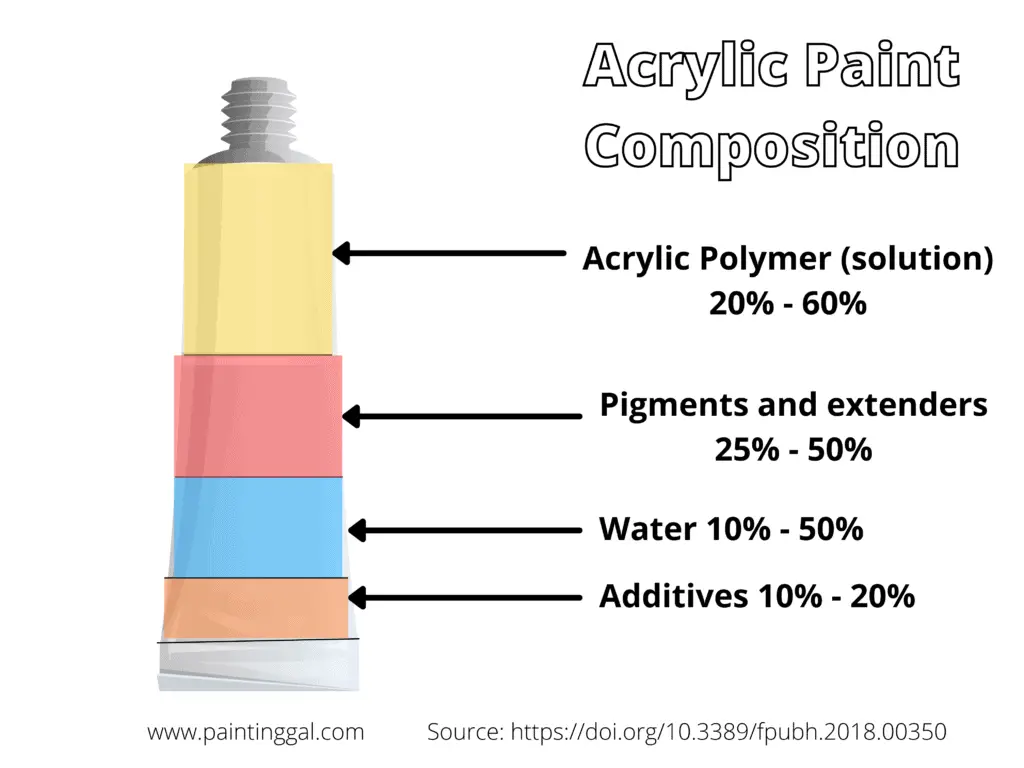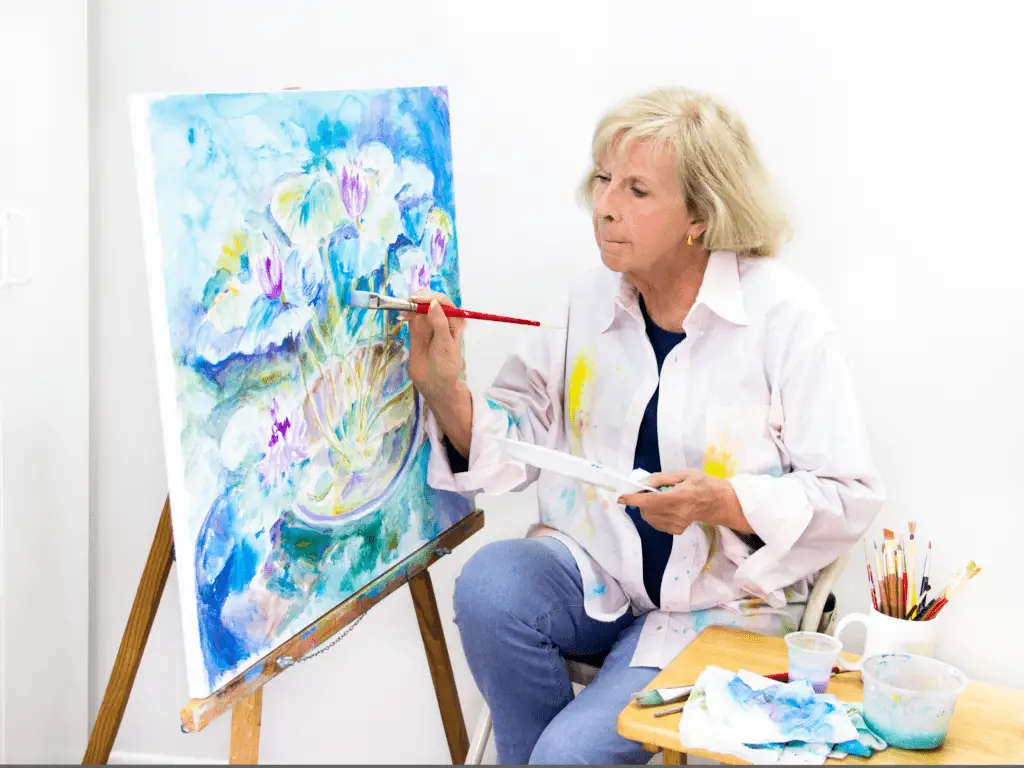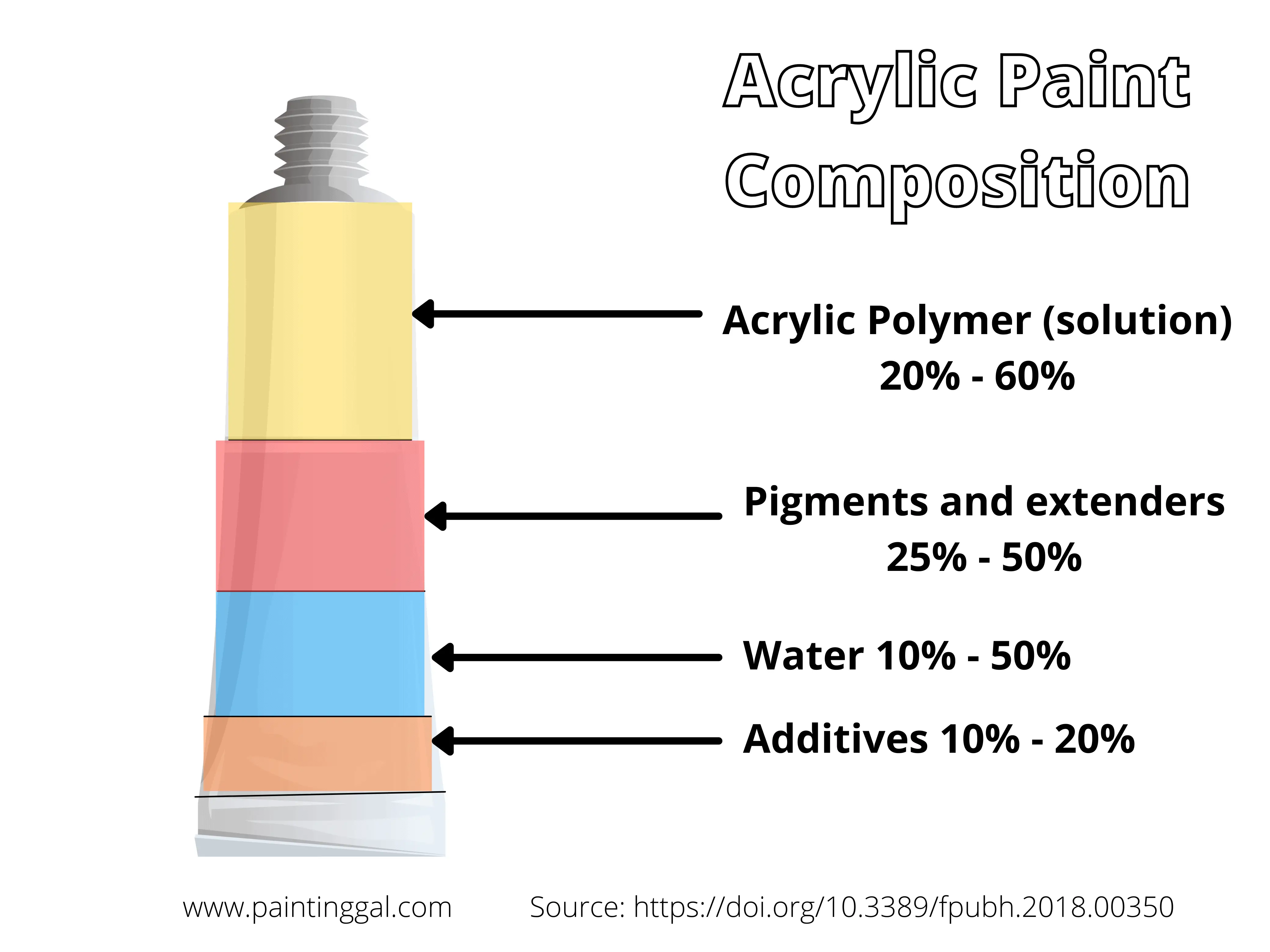As a beginner, it is easy to be confused with many aspects of painting. You might wonder if acrylic paint is water-based?
Acrylic paints were first developed as solvent-based paint for artists in the early twenties. The water-based acrylic paint that we use today are developed and launched in 1955. Therefore almost all acrylic paints that we use today are water-based made by suspending color pigments in an acrylic polymer-water emulsion.
When it comes to painting knowledge is power. Knowing what is in a paint tube and how it works is equally important as practicing painting.
Is acrylic paint water-based or solvent-based?
Almost all acrylic paints that we use today are made with water-based, acrylic polymer emulsions where pigments are dispersed. But acrylic paints are first developed as mineral spirit solvent-based paints, as same as oil paint between 1946 and 1949 by Leonard Bocour and Sam Golden.

Water-based acrylic binders were first introduced in house paints. Manufactures then thought of using the same water-based binders in artist paints. In 1955 Henry Levison introduced an artist to paint with acrylic polymer and pigments emulsified in water. He named this paint Liquitex. It is the same world-renowned brand of acrylics we use today.
Afterward, Golden also developed a water-based acrylic paint called ‘Aquatec’. Later it was developed into the artist-quality Golden acrylic paint brand. However, there is still a version of mineral spirit acrylic (MSA). It is used for conservation purposes. Here is what Golden said about water-based acrylic and their MSA paints.
The first acrylic paint for artists was invented by Sam Golden back around 1947 and it was an MSA paint called Magna. It did not become a commercial success because the first waterborne acrylics came out soon after and were more practical and safer.
Most acrylic paints and coatings are waterborne products. All main types of artist grade acrylic paints are waterborne. We do make some mineral spirit borne acrylic products but the paints are mainly used in conservation. They are called as Mineral Spirit Acrylic (MSA) paint.
Scott Bennett, Materials Specialist from Golden
These MSA paints of Golden are a combination of acrylic and oil paint properties. Mineral spirits are used to thin MSA paint. They dry quickly as acrylics but can be reactivated again with mineral spirits.
These paints have a bad odor due to volatile compounds that can be toxic if inhaled extensively. All the precautions must be taken when using, cleaning, and disposing of MSA paint like oil paint. Make sure you use a well-ventilated space when using MSA paints.
Generally, acrylic artists do not need to use MSA paints, because it brings the same caveats as oil paints to your painting process. But if you want to experience the history of acrylic paints, to experience how it all began, MSA paints are the way to go. If you are interested in learning more about MSA paint, you can watch the following video.
These paints are very hard to find on the market as they are not intended to be used by artists for general artistic purposes. You can find them at Talas. But these paints are twice as expensive as artist-quality acrylic paint from Golden. They are sold in 1 fl. oz jars.
Is acrylic paint the same as water-based paint?
Acrylic paint is one of the popular water-based paint for artists. But it differs from other water-based paints such as watercolor and gouache, due to its acrylic polymer binder. It allows acrylic paint to dry quickly into a plastic film that is water-resistant meaning it cannot be reactivated with water.
Water-based paint is paint that is manufactured with water as the solvent. It contains filler, pigments, and binder, all dissolved in water. Most common water-based paints used by artists include acrylic paint, watercolor and gouache paint.
Dana F. from Arteza
The three main water-based paints made for artists are acrylic, watercolor, and gouache. Tempera paint and poster paints are water-based paints designed for students and preschoolers.
Oil paint on the other hand is the total opposite. Its solvent is oils. Oil paints are made by grinding oil such as linseed oil with pigments. You can change the consistency of the paint by mixing it with the same linseed oil or turpentine. Once oil paint is exposed to air, it oxidizes and dries into a hard, solid film that lasts for centuries.
These are water-based paints for artists. But it is the same for house paints as well. Latex and acrylic paints used in house painting projects are water-based. Acrylic house paints are made from acrylic polymer resin, water, and pigments. They can also contain PVA (Polyvinyl Acetate). Latex paint is a combination of acrylic resin and PVA.
In the past rubber is used as the binder of latex paint. But modern latex paints contain a mixture of acrylic and vinyl but are still sold under the name latex.
Does acrylic paint wash off with water?
Wet or dry acrylic paint can be washed off with water and soap on most surfaces. Clean the brushes with soap and water first, then with acetone, denatured alcohol, or equivalent product. When covering acrylic on the canvas after drying, paint over with a top paint layer. Acrylic dried on fabric is permanent.
You can clean acrylic paint from your hands, before drying, and after drying with water and soap. Clean acrylic paint on fabric with soap, window cleaner, or both. If dried on fabric, it is permanent.
You can clean your brushes with soap and water first. Then clean the dried brushes with a cleaning solution such as acetone and denatured alcohol. Be cautious with cleaning solutions as such, because they are toxic.

When painting, if you did a mistake on the surface while wet, clean with a wet cloth or mix with water, and then dab off with tissue paper. If the paint is dry, paint over the mistake with your desired color. If not adhered well to the painting surface, you can spray some water on it and rub it off where you don’t want it.
I have written a whole article about ‘is acrylic paint waterproof‘. You will find the best ways to make acrylic paint waterproof there.
Is it 100% acrylic water-based?
100% acrylic paint used in house painting projects is water-based. They only use acrylic resin as the binder and no polyvinyl acetate (PVA). They can be thinned with water and washed off with water. It is best for exterior surfaces as they are more flexible and easy to clean up. Has a glossy finish.
I have written a whole article about the pros and cons of acrylic house paints. It will tell you all about using acrylic paint on the exterior of your house surfaces and more.
I have also compared other water-based paints with acrylic paint. You can find that article in the following link: Acrylic paint vs. water-based paint: All you need to know.
Acrylic paint and latex paints are two different paints. Acrylic paint has a high concentration of acrylic polymer binder, while latex paints have synthetic latex with PVA and /or acrylic polymers as their binder. If your paint has only acrylic polymers it will be indicated on the label as 100% acrylic.
Other than house paints, artist-quality paints only contain acrylic polymer binder, pigments, and water. They do not contain any fillers as in low-quality paint that is used to extend paint such as calcium carbonate powder and marble dust.
I have written an article series about common acrylic paint questions and answers: part 1 and part 2. You can find answers to questions like this in the articles even before you face them.
Conclusion
Acrylic paint is water-based paint. Mainly a tube of acrylic paint used by artists has pigments for color, a binder to glue the pigments together onto a surface, and water or a solvent to keep the paint wet and prevent drying before the artist is intended to. If your paint is water-based, then you can use water to thin the paint and wash off the paint when needed. But if the paint is oil or solvent-based, you will need a solvent to dissolve paint and wash off the paint. Care must be taken when using, cleaning, and disposing of solvent-based paints.
Acrylic paints were first developed as solvent-based paint by Golden. Then it was first developed into water-based acrylic paint by the founder of Liquitex. It made the painting process much easier for artists. Water-based acrylic paints don’t have any special protocols to use, clean, and dispose of. Most importantly they dry quickly.


